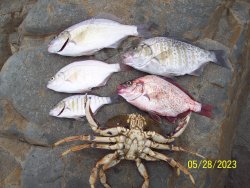The day After
- Thread starter Once You're Hook
- Start date
Northern CA, San Mateo County, Weather condition was breezy overcast sky, surf was fairly rough with strong sidewash. waited for the surf to subsided before the fish started to be active, it remain like that for about a good portion of 45 minutes. Bait was the good reliable sandcrabs with a Carolina Rig setup.
Calico Surfperch
Species: Amphistichus koelzi (Hubbs, 1933); from the Greek words amphi (double) and stoichos (series, referring to the two rows of teeth in each jaw) and Walter Koelz, a U.S. ichthyologist.
Alternate Names: Surf perch, humpback perch, porgie (or porgee). Called majarra angaripola or perca in Mexico.
Identification: Their coloring is silvery, with olive-green mottling and bars on sides (bars usually broken and disconnected); most fins are reddish colored; caudal fin (tail) pinkish to deep red. Longest dorsal fin spines about equal to or slightly longer than longest dorsal soft-ray; pronounced notch between dorsal fin hard rays and soft rays. Lower edge of eye is below the upper lip. More disc-like shaped than in redtail surfperch.
Size: To 12.8 inches; most caught from piers are 9-11 inches. The California record fish weighed 2 Lbs 0 oz and was taken at Marina Beach, Monterey Co. in 2019.
Range: Los Ojitos, central Baja California, Arroyo San Isidro, northern Baja California, to Shi Shi Beach, Cape Flattery, Washington. Common from northern Baja California, to about southern Oregon.
Habitat: Typically in surf zone, shallow-water, sandy-shore areas; recorded to a depth of 30 feet.
Piers: Calico surfperch are the number one large surfperch caught on central California piers north of Cayucos. In the Pismo Beach-Cayucos region, large numbers of both barred surfperch and calico surfperch are caught; more barred surfperch are landed but the calico surfperch will be slightly larger in size. Best bets: Avila Pier, Cayucos Pier, San Simeon Pier, Seacliff State Beach Pier, Capitola Wharf, Santa Cruz Wharf, Pacifica Pier and (surprisingly) Point Arena Pier.
Shoreline: One of the main fish for sandy shore anglers in central California anglers.
Boats: An inshore species rarely taken by boaters.
Bait and Tackle: Bait and tackle is the same for all three of the large surfperch. Best bait is live sand crabs followed by live sea worms (pile worms or bloodworms); next would be fresh mussels, shrimp or clams. Tackle should be heavy enough to hold bottom in the surf area, and hooks should be size 6 to size 2 baited on a high/low leader.
Food Value: Mild-flavored flesh with small flakes and a soft texture. The flesh is white colored and low in fat content. Can be cooked in any manner but most commonly fried.
Comments: Calico surfperch will often school right around the inshore pilings; at times, fishing right under the pier, as close to these pilings as possible, will yield the largest fish. Calicos are sometimes mistaken for redtail surfperch.
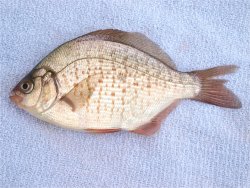
Fresh caught Calico Surfperch (by myself) from the San Simeon Pier
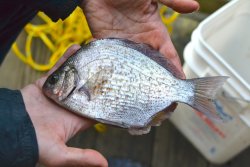
Calico Surfperch caught at Trinidad. Colors tend to fade after death.
Redtail Surfperch
Species: Amphistichus rhodoterus (Agassiz, 1854); from the Greek words amphi (double), stoichus (series, referring to the two rows of teeth in each jaw), and rhodoterus (rosy).
Alternate Names: Redtail perch, rosy surf fish and porgy (or porgie).
Identification: Their coloring is silver with olive green mottling and bars on side; fins red with the caudal fin (their tail) pink to deep purple. The longest dorsal spines are longer than the dorsal soft-rays. More elongate than calico surfperch.
Size: To 16 inches and 4 pounds; most caught from piers are under a foot. The California record fish weighed 3 Lbs 7 oz and was taken at Kellogg Beach, Del Norte Co. in 2012.
Range: Punta Baja, northern Baja California, to Kyuquot Channel, northwest Btitish Columbia. Common from northern California, to Vancouver Island, British Columbia.
Habitat: Surf zone, shallow-water, sandy-shore, oceanfront areas; recorded to a depth of 24 feet. Although generally found in the open ocean, they enter sheltered estuaries and bays just before spawning in the spring and early summer. At such times, hundreds of fish may be concentrated in a fairly small area and it's pretty easy for anglers to catch a limit.
Piers: Commonly caught at sandy-shore piers and bay piers north of Pacifica. Best bets: Pacifica Pier, Del Norte St. Pier (Eureka), and both the “B” Street Pier and Citizen's Dock in Crescent City.
Shoreline: One of the main fish for sandy shore anglers in northern California anglers.
Boats: An inshore species but sometimes taken by boaters fishing Humboldt Bay.
Bait and Tackle: Use medium tackle, a large enough sinker to hold bottom, a high/low sinker, and hooks size 6 to 2. Best baits include live sand crabs (in the surf areas), fresh mussels, pile worms or bloodworms, and clams. North of Eureka, two favorite baits are tube worms (generally frozen) and crab backs.
Food Value: Mild-flavored flesh with small flakes and a soft texture. The flesh is white colored and low in fat content. Can be cooked in any manner but most commonly fried.
Comments: Redtail surfperch, along with barred surfperch and calico surfperch make up the trio of large surfperch that dominate action on the surf end of most California piers; all are fine sportfish and fine eating.
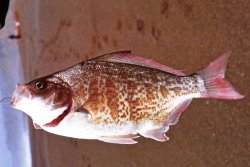
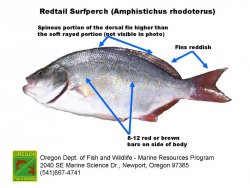
Species: Amphistichus koelzi (Hubbs, 1933); from the Greek words amphi (double) and stoichos (series, referring to the two rows of teeth in each jaw) and Walter Koelz, a U.S. ichthyologist.
Alternate Names: Surf perch, humpback perch, porgie (or porgee). Called majarra angaripola or perca in Mexico.
Identification: Their coloring is silvery, with olive-green mottling and bars on sides (bars usually broken and disconnected); most fins are reddish colored; caudal fin (tail) pinkish to deep red. Longest dorsal fin spines about equal to or slightly longer than longest dorsal soft-ray; pronounced notch between dorsal fin hard rays and soft rays. Lower edge of eye is below the upper lip. More disc-like shaped than in redtail surfperch.
Size: To 12.8 inches; most caught from piers are 9-11 inches. The California record fish weighed 2 Lbs 0 oz and was taken at Marina Beach, Monterey Co. in 2019.
Range: Los Ojitos, central Baja California, Arroyo San Isidro, northern Baja California, to Shi Shi Beach, Cape Flattery, Washington. Common from northern Baja California, to about southern Oregon.
Habitat: Typically in surf zone, shallow-water, sandy-shore areas; recorded to a depth of 30 feet.
Piers: Calico surfperch are the number one large surfperch caught on central California piers north of Cayucos. In the Pismo Beach-Cayucos region, large numbers of both barred surfperch and calico surfperch are caught; more barred surfperch are landed but the calico surfperch will be slightly larger in size. Best bets: Avila Pier, Cayucos Pier, San Simeon Pier, Seacliff State Beach Pier, Capitola Wharf, Santa Cruz Wharf, Pacifica Pier and (surprisingly) Point Arena Pier.
Shoreline: One of the main fish for sandy shore anglers in central California anglers.
Boats: An inshore species rarely taken by boaters.
Bait and Tackle: Bait and tackle is the same for all three of the large surfperch. Best bait is live sand crabs followed by live sea worms (pile worms or bloodworms); next would be fresh mussels, shrimp or clams. Tackle should be heavy enough to hold bottom in the surf area, and hooks should be size 6 to size 2 baited on a high/low leader.
Food Value: Mild-flavored flesh with small flakes and a soft texture. The flesh is white colored and low in fat content. Can be cooked in any manner but most commonly fried.
Comments: Calico surfperch will often school right around the inshore pilings; at times, fishing right under the pier, as close to these pilings as possible, will yield the largest fish. Calicos are sometimes mistaken for redtail surfperch.

Fresh caught Calico Surfperch (by myself) from the San Simeon Pier

Calico Surfperch caught at Trinidad. Colors tend to fade after death.
Species: Amphistichus rhodoterus (Agassiz, 1854); from the Greek words amphi (double), stoichus (series, referring to the two rows of teeth in each jaw), and rhodoterus (rosy).
Alternate Names: Redtail perch, rosy surf fish and porgy (or porgie).
Identification: Their coloring is silver with olive green mottling and bars on side; fins red with the caudal fin (their tail) pink to deep purple. The longest dorsal spines are longer than the dorsal soft-rays. More elongate than calico surfperch.
Size: To 16 inches and 4 pounds; most caught from piers are under a foot. The California record fish weighed 3 Lbs 7 oz and was taken at Kellogg Beach, Del Norte Co. in 2012.
Range: Punta Baja, northern Baja California, to Kyuquot Channel, northwest Btitish Columbia. Common from northern California, to Vancouver Island, British Columbia.
Habitat: Surf zone, shallow-water, sandy-shore, oceanfront areas; recorded to a depth of 24 feet. Although generally found in the open ocean, they enter sheltered estuaries and bays just before spawning in the spring and early summer. At such times, hundreds of fish may be concentrated in a fairly small area and it's pretty easy for anglers to catch a limit.
Piers: Commonly caught at sandy-shore piers and bay piers north of Pacifica. Best bets: Pacifica Pier, Del Norte St. Pier (Eureka), and both the “B” Street Pier and Citizen's Dock in Crescent City.
Shoreline: One of the main fish for sandy shore anglers in northern California anglers.
Boats: An inshore species but sometimes taken by boaters fishing Humboldt Bay.
Bait and Tackle: Use medium tackle, a large enough sinker to hold bottom, a high/low sinker, and hooks size 6 to 2. Best baits include live sand crabs (in the surf areas), fresh mussels, pile worms or bloodworms, and clams. North of Eureka, two favorite baits are tube worms (generally frozen) and crab backs.
Food Value: Mild-flavored flesh with small flakes and a soft texture. The flesh is white colored and low in fat content. Can be cooked in any manner but most commonly fried.
Comments: Redtail surfperch, along with barred surfperch and calico surfperch make up the trio of large surfperch that dominate action on the surf end of most California piers; all are fine sportfish and fine eating.

Fresh caught Redtail Surfperch (by my son Mike north of Trinidad). Side colors tend to fade after death.


